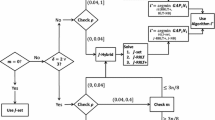Abstract
Multiple objective linear programming (MOLP) is almost universally implemented within a simplex algorithm and relies on some of its properties, in particular the use of bases. Alternative linear programming methods such as the projective method need not use bases. Yet, their most common approach to post-optimal analysis has been conservative, e.g. reconstructing a basis in order to use the classical framework. A second, less investigated approach, is to adapt the scope of MOLP to the new methods. The simplex and the new methods are affected differently by degeneracy that causes numerical difficulties both in the data representation and the solution process. Symbolic solvers can mitigate such difficulties. Formulating MOLP as disjunctive optimization related to logic programming, the constraint logic program CLP(ℜ) is selected for its symbolic treatment of algebraic constraints seamlessly embedded in a Prolog syntax.
Supported by NSERC Grant OGP0042197 and AUCC Going Global Program.
Access this chapter
Tax calculation will be finalised at checkout
Purchases are for personal use only
Preview
Unable to display preview. Download preview PDF.
Similar content being viewed by others
References
Adler, I., Monteiro, R.D.C.: Limiting behaviour of the affine scaling continuous trajectories for linear programming problems. Mathematical Programming 50 (1991) 29–51
Adler, I., Monteiro, R.D.C.: A Geometric View of Parametric Linear Programming Algorithmica 8 (1992) 161–176
Adler, I., Verma, S.: Linear and Convex Optimization by Neural Networks. ORSA Computer Science Technical Section Conference, Williamsburg, Virginia, January 6, 1994
Barnes, E.R.: A Variation on Karmarkar’s Algorithm for Solving Linear Programming Problems. Mathematical Programming 36 (1986) 174–182
Brown, R.G., Chinneck, J.W., Karam, G.M.: Optimization With Constraint Programming Systems. in Impact of Recent Computer Advances on Operations Research, R. Sharda ed., North Holland (1989) 463–473
Charnes, A., Cooper, W.: Management Models and Industrial Applications of Linear Programming, John Wiley & Sons, New York, 1961
Cohen, M.: Constraint Logic Programming Languages. Communications of the ACM (1990) 52–68
Colmerauer, A.: Prolog and Infinite Trees, Groupe Intelligence Artificielle, Faculté des Sciences de Luminy, Université Aix-Marseille II, 1982
Complete Logic Systems: Trilogy User’s Guide, North Vancouver, British Columbia, Canada, 1987
Dantzig, G.B.: Linear Programming and Extensions, Princeton University Press, Princeton, N.J., 1963
Dikin, I.I.: Iterative Solution of Problems of Linear and Quadratic Programming. Soviet Mathematics Doklady. 8 3 (1967) 674–675
Gal, T.: Degeneracy problems in mathematical programming and degeneracy graphs. ORION 6 1 (1990) 3–36
Gal, T., ed.: Degeneracy in Optimization Problems. Annals of Operations Research, 1994
Geoffrion, A.M., Dyer, J.S., Feinberg, A.: An Interactive Approach for Multiple Optimization with Applications to the Operation of an Academic Department, Management Science 19 (1972) 357–368
Gill, P.E., Murray, W., Saunders, M.A., Tomlin, J.A., Wright, M.H.: On Projected Newton Barrier Methods for Linear Programming and an Equivalence to Karmarkar’s Projective Method. Mathematical Programming 36 (1986) 183–209
Hansen, P., Labbé, M., Wendell, R. E.: Sensitivity analysis in multiple objective linear programming: The tolerance approach. European Jour. of Operational Research 38 1 (1989) 63–69
Ignizio, J.P.: Goal Programming and Extensions, D.C. Heath, Lexington, Massachusetts, 1993
Jaffar, J., Michaylov, S., Stuckey, P.J., Yap, R.H.C.: The CLP(91) Language and System. Technical Report 16292 (#72336), IBM Research Division, Yorktown Heights, 1990
Jansen, B., Roos, C., Terlaky, T.: Optimal Bases versus Optimal Partitions for Postoptimal Analysis in Linear Programming, Technical Report 92–21, Fac. of Techn. Math./Computer Science, Delft University of Technology, revised in May 1993
Karmarkar, N.: A New Polynomial-Time Algorithm for Linear Programming. Combinatorica 4 (1984) 373–395
Khachiyan, L.G.: A Polynomial Algorithm in Linear Programming. Soviet Mathematics Doklady 20 1 (1979) 191–194
Konopasek, M., Jayaraman, S.: The TK! Solver Book, Osborne/McGraw-Hill, Berkeley, Ca. 1984
Mangasarian, O.L.: Iterative solution of linear programs. SIAM Journal on Numerical Analysis 18 (1981) 606–614
Megiddo, N., Shub, M.: Boundary Behavior of Interior Point Algorithms in Linear Programming. Mathematics of Operations Research 14 (1989) 97–146
Megiddo, N.: On Finding Primal-and Dual-Optimal Bases. ORSA Journal on Computing 3 1 (1991) 63–65
Mehrotra S., Monteiro, R.D.C.: Parametric and Range Analysis for Interior Point Methods, Technical Report, Department of Industrial Engineering, University of Arizona, April 1992
Rockafellar, R.T.: Monotone Operators and the Proximal Point Algorithm. SIAM Journal on Control and Optimization 14 5 (1976) 877–898
Shambin, J.E., Stevens Jr., G.T.: Operations Research: A Fundamental Approach, McGraw-Hill, New York, 1974
Steuer, R.E.: Multiple Criteria Optimization: Theory, Computation, and Application, John Wiley & Sons Inc., New York, 1986
Vanderbei, R.J., Meketon, M.S., Freedman, B.A.: A Modification of Karmarkar’s Linear Programming Algorithm. Algorithmica 1 (1986) 395–407.
Wolfram, S.: Mathematica: a system for doing mathematics by computer, Addison-Wesley Pub. Co., Redwood City, Calif., 1991
Wright, S.J.: Implementing Proximal Point Methods for Linear Programming. Mathematics and Computer Science Division, Argonne National Laboratory, preprint MCS-P45–0189, 1989
Zionts, S., Wallenius, J.: An Interactive Programming Method for Solving the Multiple Criteria Problem. Management Science 22 (1976) 652–663
Author information
Authors and Affiliations
Editor information
Editors and Affiliations
Rights and permissions
Copyright information
© 1996 Springer-Verlag Berlin Heidelberg
About this chapter
Cite this chapter
Thizy, JM. (1996). Projective and Symbolic Degeneracy-Reducing Techniques for Multiple Objective Linear Programming. In: Tamiz, M. (eds) Multi-Objective Programming and Goal Programming. Lecture Notes in Economics and Mathematical Systems, vol 432. Springer, Berlin, Heidelberg. https://doi.org/10.1007/978-3-642-87561-8_10
Download citation
DOI: https://doi.org/10.1007/978-3-642-87561-8_10
Publisher Name: Springer, Berlin, Heidelberg
Print ISBN: 978-3-540-60662-8
Online ISBN: 978-3-642-87561-8
eBook Packages: Springer Book Archive




